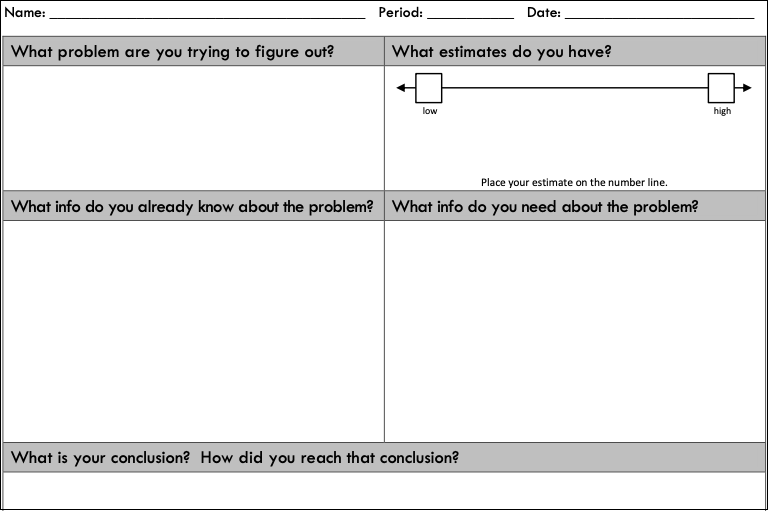- MN ABE Connect
- Archive
- What Seems to Be the Problem?
 March 29, 2021
March 29, 2021
What Seems to Be the Problem?
Stephanie Sommers, ACES CoordinatorOne thing I love about the COABE conference is that you never know where you are going to find inspiration. Sometimes you attend a session that is pure gold from start to finish, but more often than not, it’s the little nuggets of gold that are buried within a session that I find most valuable.
This is how I found out about Robert Kaplinsky and his problem-solving framework during last week’s national conference. I was attending a session that focused on a 4-step process for lesson planning, and the presenter included a single slide with the framework. As I am not a math teacher, I had never heard of Mr. Kaplinsky, but the framework got my ACES senses tingling, so I took to Google to find out more.
What I found is that Robert Kaplinsky has an entire website devoted to helping students become better problem solvers, critical thinkers, and mathematical reasoners. His website contains a number of free, downloadable lesson plans that are built around real-life situations and take a problem-based learning approach. The lessons are leveled from Kindergarten through 8th grade, with additional lessons for Algebra and Geometry.

Many of the lessons could be included as math or numeracy practice in integrated and contextualized lessons or units that focus on larger themes, such as safety, transportation, health literacy, and financial literacy. The lessons contain high-interest materials, such as videos and infographics, and they are aligned to content standards. In short, these are high-quality learning materials, and they are absolutely free. You don’t even need to create a user account.
Kaplinsky’s problem-solving framework
While the outstanding lessons certainly provide enough of a reason to visit Mr. Kaplinsky’s website, it’s the Problem Solving Framework that I would like to highlight. The framework can be found by clicking on resources and then Problem-Based Lesson Tools:

The framework, along with the website, has also been added to the ACES resource library under Critical Thinking.
One thing that I noticed about it right away is this is version 8.1 of the framework, and Mr. Kaplinsky has a blog post that discusses some of his previous versions and the changes that he’s made (The Problem Solving Framework’s Evolution). I appreciate knowing that this has been a work in progress since 2012. I think that speaks both to Mr. Kaplinsky’s passion and his devotion.
The framework gives students a series of questions to think about as they try to solve a problem. It basically teaches them how to ask the questions that they should be asking themselves as they work through a problem.
- Define the Problem: What problem are you trying to figure out? What estimates do you have?
- Analyze the Problem: What info do you already know the problem? What info do you need about the problem?
- Solve the Problem: What is your conclusion? How did you reach that conclusion?

The ACES connection
This is all wonderful and amazing, but, as I have already mentioned, I am not a math teacher, so what’s my interest in this? Well, I see this simple framework as having useful applications outside of the math classroom. We know that problem-solving skills are extremely important. They are defined in the Critical Thinking category of the Transitions Integration Framework (TIF).
Specifically, Skill 2 tells us that we should be teaching our adult learners how to:
- Clearly articulate the component parts of a problem
- Identify the information needed to solve a problem
- Identify and evaluate potential solutions
Sounds a lot like a certain framework someone was just telling you about, doesn’t it?
We know that using a problem-based instructional approach has many benefits for adult learners. The lessons are generally highly engaging, which means learners are motivated to learn. The lessons tend to work well for integrating multiple sets of standards or skills, and they are easy to connect to authentic, real-world contexts. Here are just a few ideas for how the Problem Solving Framework could be used in an ABE classroom:
- Figuring out how much money a person would need to earn in order to maintain a certain lifestyle
- Calculating how much money a new job would have to pay in order to make it worth it to relocate to a new city
- Planning how much time (and/or money) would be needed to reach a particular goal
- Calculating how many hours would need to be worked in order to make a large purchase
- Estimating how many students would need to enroll in a class and how often they would need to attend in order to pay the teacher’s salary
Admittedly, my examples all still have something to do with numbers, but I think the framework could be used to help students unpack a writing prompt, for example, or understand a complex question on the GED test. Try swapping the word “problem” for “question” or “prompt” in the questions from the framework, and see what develops. Put your adaptive expertise to use, and soon you’ll be helping your students develop the critical thinking skills that employers prize.
ACES Spring Webinar – April 21
For more opportunities to connect with ACES, please join us on Wednesday, April 21, 2021 for the ACES Spring Webinar. The topic, which was suggested by previous webinar participants, will be using ACES/TIF to teach Workforce Preparation Skills. We will be joined by three teachers during the webinar who will share lessons they have developed for IET and IELCE classes that successfully address the workforce preparation requirement by aligning the lesson to ACES/TIF.
Newsletter Signup
Get MN ABE Connect—the official source for ABE events, activities, and resources!
Sign UpArticle Categories
- ABE Foundations/Staff Onboarding
- ACES/Transitions
- Adult Career Pathways
- Assessment
- CCR Standards
- Citizenship
- COVID-19
- Cultural Competency
- Digital Literacy/Northstar
- Disabilities
- Distance Learning/Education
- ELA
- Equity/Inclusion
- ESL
- HSE/Adult Diploma
- Listening
- Math/Numeracy
- Mental Health
- Minnesota ABE
- One-Room Schoolhouse/Multilevel
- Professional Development
- Program Management
- Reading
- Remote Instruction
- Science
- Social Studies
- Speaking/Conversation
- Support Services
- Teaching Strategies
- Technology
- Uncategorized
- Volunteers/Tutors
- Writing